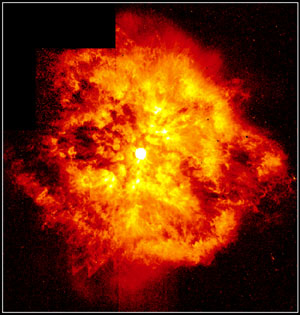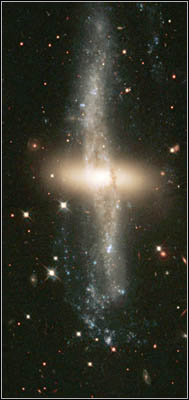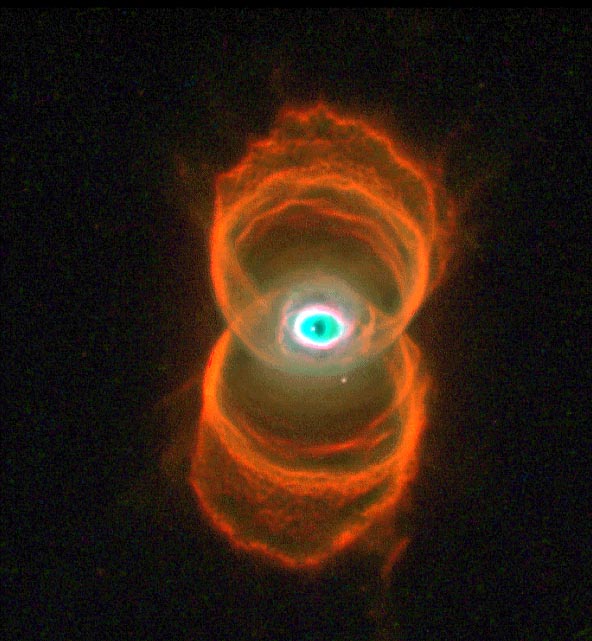BIG BANG? Hah!
"If it disagrees with experiment, IT'S WRONG!".... Richard Feynman
"If it disagrees with observation, IT'S WRONG!"....Charles Wagner

Introduction
I believe that the world is on the brink of a revolution in thought unlike any seen since the overthrow of Ptolemic geocentrism. Two of the major ideas that have permeated the thinking of the 20th century are under attack and will probably be overturned in the next millenium. These two ideas currently in a state of crisis are darwinian evolution and big bang cosmology. The fall of big bang cosmology will probably be worse, since it will likely take with it the current thinking in particle physics and thermodynamics. The main reasons for these crises lie in the fact that both cosmology and evolution seem to be exempt from the scientific requirement that they be supported by observation and experimentation. They are grounded in deductive, rather than inductive logic. They fail to see the simple logical error of assuming that if all dogs have tails, and this animal has a tail, then it must be a dog. In short, these two ideas come closer to being religious beliefs than scientific theories. Worse yet, in spite of a growing body of observational evidence to falsify them, both of these theories continue to be staunchly defended by their supporters. "If we only make a few adjustments..."

What is the Big Bang?
The big bang theory of cosmology says that the universe came into existence in a single event some ten or twenty billion years ago from a single, infinitely dense and hot pointlike ball of light, smaller than the smallest atom. In a fraction of a second, it expanded trillions of times creating all of the space, matter and energy that now makes up the galaxies and stars. The universe has been expanding and cooling since that initial event.
Evidence for the Big Bang
The evidence for the big bang theory falls into three general catagories. The first is that as the universe is expanding, the galaxies receed from each other with a velocity proportional to the distance between them. Edwin Hubble studied the red-shifts of galaxies and inferred just such an expansion law. The second evidence comes from the prediction that there should be a cosmic background radiation bathing the universe that is a remnant of the intense heat of its origin. This radiation should come uniformly from all directions and have a temperature of about 3 K. This prediction was confirmed in 1964. The third evidence is that successful predictions have been made for the synthesis of light atomic nuclei from protons and neutrons during the first minutes after the big bang. These abundances have been obtained and seem to agree with the predictions.
Problems with the Big Bang
False Assumptions?
The first problem involves the three predictions that the big bang theory makes, that the universe is expanding, that the cosmic background radiation exists and that the abundances of light elements are correct. The idea that the universe is expanding is based upon an assumption that may be false. This assumption is that the observed red-shift is a cosmological effect and is not an anomoly. Photographs taken by Halton Arp suggest the possibility that some objects which appear to be physically connected show widely divergent red-shifts. If it can be shown that the red-shifts are not cosmological, this would undermine Hubbles law, and the big bang theory. Likewise, the cosmic background radiation could be a general condition of the universe, not at all related to any big bang event. It's an example of the false logic mentioned above.

Superclusters
But these problems are not fatal. The really serious problems directly contradict the big bang theory with observational data. If the big bang occurred 20 billion years ago, it seems logical to assume that nothing in the universe can be older than this. Yet, mammoth clusters of galaxies have been discovered that are billions of light years across. Such clusters would take hundreds of billions of years to form, far longer than the universe has existed. A second part of the problem is that the universe is presumed to have started out smooth and homogeneous, like the background radiation. Recent observations have shown the actual universe to be profoundly discontinuous and clumpy. There are vast areas where there is nothing, and enormous ribbons of matter stretch out over the universe like strings of christmas lights. Another part of the problem is the alleged "dark matter". For the big bang theory to be correct, 99% of the universe must be made up of this invisible and unobserved form of matter. Yet, there is no evidence that this "dark matter" actually exists at all.
Role of Gravity
One of the basic assumptions of the big bang theory is that the universe is smooth and homogeneous on the largest scales. In addition, the theory assumes that such a universe is dominated by gravity alone. Following these two assumptions, it is further required, according to general relativity, that the universe as a whole must either expand or contract from a single point, a singularity. The discovery by Brent Tulley, that all galaxies within one billion light years of earth are concentrated into huge ribbons of matter about a billion light years long, 300 million light years wide and 100 million light years thick belies that homogeneity an the grandest of scales.

Background Radiation
When cosmologists thought that the universe was smooth and homogeneous on its largest scales, they were happy to find that the background radiation matched perfectly to a "black body" curve. But when it became clearer that this smoothness did not really exist, it became necessary to find bumps in the background radiation, tiny non-conformities that could explain how the universe got from its smooth, homogeneous beginnings to a clumpy, discontinous present. Data from the COBE probe in 1989 seemed to confirm the perfect smoothness of the background radiation, although later interpretations by George Smoot claim to have found the necessary bumps. The picture above is from COBE data that purports to show the anisotropies in the cosmic background radiation
Dark Matter
For galaxies to have formed as a result of the big bang, there must have been enough matter in the universe so that gravitation would eventually halt the expansion. This requires a density of about 10 atoms per cubic meter. The density of the universe is expressed by a ratio called Omega, the density needed to stop expansion. Just enough matter to stop the expansion would have an omega value of 1. But the omega value of the universe came out to be closer to .01-.02. Hardly enough matter to stop the expansion and magnify the fluctuations fast enough to form galaxies. Omega had to be close to one, and the only possible explanation was that 99% of the matter in the universe was invisible, "dark matter".
A further problem was that if observation was to match theory as far as the abundances of the light elements, the omega for ordinary matter could not be greater than about .02-.03. Therefore, this invisible dark matter could not be ordinary matter, it had to be some form of exotic matter. Most of the evidence collected so far gives no indication that this huge amount of invisible matter exists. As far as the universe is concerned, what you see is what there is.
Alternatives to the Big Bang
 There is another theory of cosmology called Plasma Cosmology, pioneered by Hannes Alfven, a swedish Nobel laureate and the father of modern plasma physics. Alfven claims that the universe has always existed and is always evolving and will continue to exist and evolve forever. In addition, Alfven envisions a universe in which electricity and magnetism, not only gravity, play significant roles. Lack of homogeneity is a fundamental part of plasma behavior. Plasma can be studied here in laboratories and pinches itself together into dense, swirling filaments, separated by diffuse voids, very similar to what we observe in the universe. The picture at right of the Hourglass nebula taken by the HST shows possible plasma filaments created by the interaction of plasma, electricity and magnetism.
There is another theory of cosmology called Plasma Cosmology, pioneered by Hannes Alfven, a swedish Nobel laureate and the father of modern plasma physics. Alfven claims that the universe has always existed and is always evolving and will continue to exist and evolve forever. In addition, Alfven envisions a universe in which electricity and magnetism, not only gravity, play significant roles. Lack of homogeneity is a fundamental part of plasma behavior. Plasma can be studied here in laboratories and pinches itself together into dense, swirling filaments, separated by diffuse voids, very similar to what we observe in the universe. The picture at right of the Hourglass nebula taken by the HST shows possible plasma filaments created by the interaction of plasma, electricity and magnetism.
Conclusion
We have not yet addressed the basic question of why evolutionary biology and cosmology are exempt from the basic rules of science. In no other branch of science would a theory's failure be covered up by a flood of unsupported corrections. It would simply not be tolerated. The ability of a scientific theory to be falsified is a basic principle of science that separates science from metaphysics. If a theory continues to be supported and defended in light of direct, clear observational data that refute it, then we cannot predict anything in science, it becomes worthless.
The reason, I believe, is simple. Both darwinian evolution and big bang cosmology have become religious beliefs. They are defended, not on observational and experimental evidence, but on faith alone. We believe the theories to be true, therefore, everything must be explained in that context. That the theory is correct is a given, an axiom on which everything else is built.
Books and Links
A very good book on Plasma Cosmology is "The Big Bang Never Happened" (subtle, huh?) by Eric Lerner. There is also a very nice photo gallery at the University of California at Santa Barbara that bears attention.
Also, take a look at this new site by Vincent Sauve.


 There is another theory of cosmology called Plasma Cosmology, pioneered by Hannes Alfven, a swedish Nobel laureate and the father of modern plasma physics. Alfven claims that the universe has always existed and is always evolving and will continue to exist and evolve forever. In addition, Alfven envisions a universe in which electricity and magnetism, not only gravity, play significant roles. Lack of homogeneity is a fundamental part of plasma behavior. Plasma can be studied here in laboratories and pinches itself together into dense, swirling filaments, separated by diffuse voids, very similar to what we observe in the universe. The picture at right of the Hourglass nebula taken by the HST shows possible plasma filaments created by the interaction of plasma, electricity and magnetism.
There is another theory of cosmology called Plasma Cosmology, pioneered by Hannes Alfven, a swedish Nobel laureate and the father of modern plasma physics. Alfven claims that the universe has always existed and is always evolving and will continue to exist and evolve forever. In addition, Alfven envisions a universe in which electricity and magnetism, not only gravity, play significant roles. Lack of homogeneity is a fundamental part of plasma behavior. Plasma can be studied here in laboratories and pinches itself together into dense, swirling filaments, separated by diffuse voids, very similar to what we observe in the universe. The picture at right of the Hourglass nebula taken by the HST shows possible plasma filaments created by the interaction of plasma, electricity and magnetism.